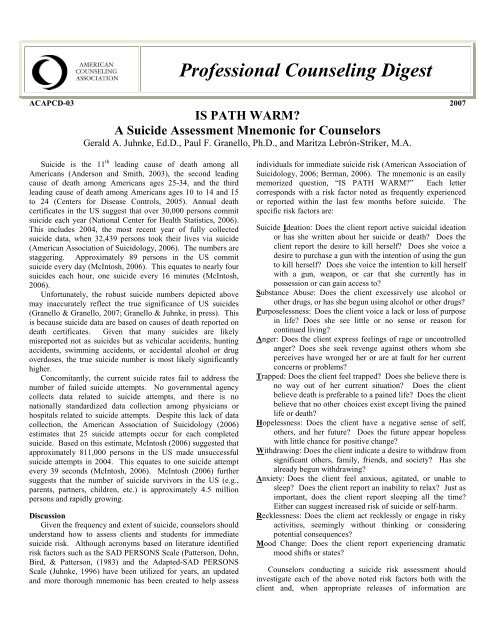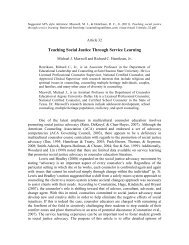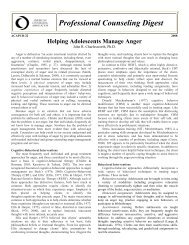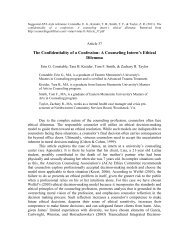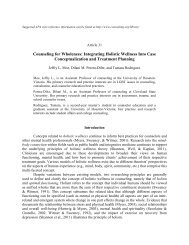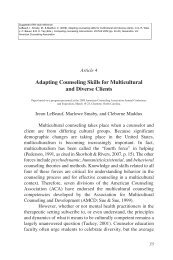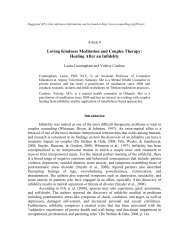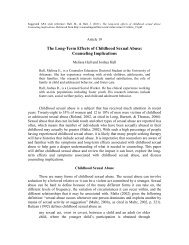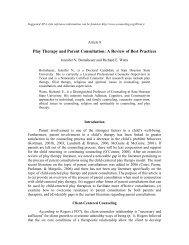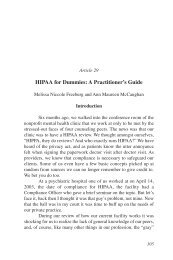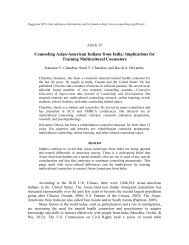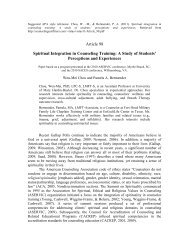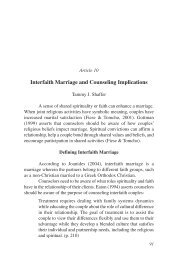IS PATH WARM? A Suicide Assessment Mnemonic for Counselors
IS PATH WARM? A Suicide Assessment Mnemonic for Counselors
IS PATH WARM? A Suicide Assessment Mnemonic for Counselors
You also want an ePaper? Increase the reach of your titles
YUMPU automatically turns print PDFs into web optimized ePapers that Google loves.
Professional Counseling DigestACAPCD-03 2007<strong>IS</strong> <strong>PATH</strong> <strong>WARM</strong>?A <strong>Suicide</strong> <strong>Assessment</strong> <strong>Mnemonic</strong> <strong>for</strong> <strong>Counselors</strong>Gerald A. Juhnke, Ed.D., Paul F. Granello, Ph.D., and Maritza Lebrón-Striker, M.A.<strong>Suicide</strong> is the 11 th leading cause of death among allAmericans (Anderson and Smith, 2003), the second leadingcause of death among Americans ages 25-34, and the thirdleading cause of death among Americans ages 10 to 14 and 15to 24 (Centers <strong>for</strong> Disease Controls, 2005). Annual deathcertificates in the US suggest that over 30,000 persons commitsuicide each year (National Center <strong>for</strong> Health Statistics, 2006).This includes 2004, the most recent year of fully collectedsuicide data, when 32,439 persons took their lives via suicide(American Association of Suicidology, 2006). The numbers arestaggering. Approximately 89 persons in the US commitsuicide every day (McIntosh, 2006). This equates to nearly foursuicides each hour, one suicide every 16 minutes (McIntosh,2006).Un<strong>for</strong>tunately, the robust suicide numbers depicted abovemay inaccurately reflect the true significance of US suicides(Granello & Granello, 2007; Granello & Juhnke, in press). Thisis because suicide data are based on causes of death reported ondeath certificates. Given that many suicides are likelymisreported not as suicides but as vehicular accidents, huntingaccidents, swimming accidents, or accidental alcohol or drugoverdoses, the true suicide number is most likely significantlyhigher.Concomitantly, the current suicide rates fail to address thenumber of failed suicide attempts. No governmental agencycollects data related to suicide attempts, and there is nonationally standardized data collection among physicians orhospitals related to suicide attempts. Despite this lack of datacollection, the American Association of Suicidology (2006)estimates that 25 suicide attempts occur <strong>for</strong> each completedsuicide. Based on this estimate, McIntosh (2006) suggested thatapproximately 811,000 persons in the US made unsuccessfulsuicide attempts in 2004. This equates to one suicide attemptevery 39 seconds (McIntosh, 2006). McIntosh (2006) furthersuggests that the number of suicide survivors in the US (e.g.,parents, partners, children, etc.) is approximately 4.5 millionpersons and rapidly growing.DiscussionGiven the frequency and extent of suicide, counselors shouldunderstand how to assess clients and students <strong>for</strong> immediatesuicide risk. Although acronyms based on literature identifiedrisk factors such as the SAD PERSONS Scale (Patterson, Dohn,Bird, & Patterson, (1983) and the Adapted-SAD PERSONSScale (Juhnke, 1996) have been utilized <strong>for</strong> years, an updatedand more thorough mnemonic has been created to help assessindividuals <strong>for</strong> immediate suicide risk (American Association ofSuicidology, 2006; Berman, 2006). The mnemonic is an easilymemorized question, “<strong>IS</strong> <strong>PATH</strong> <strong>WARM</strong>?” Each lettercorresponds with a risk factor noted as frequently experiencedor reported within the last few months be<strong>for</strong>e suicide. Thespecific risk factors are:<strong>Suicide</strong> Ideation: Does the client report active suicidal ideationor has she written about her suicide or death? Does theclient report the desire to kill herself? Does she voice adesire to purchase a gun with the intention of using the gunto kill herself? Does she voice the intention to kill herselfwith a gun, weapon, or car that she currently has inpossession or can gain access to?Substance Abuse: Does the client excessively use alcohol orother drugs, or has she begun using alcohol or other drugs?Purposelessness: Does the client voice a lack or loss of purposein life? Does she see little or no sense or reason <strong>for</strong>continued living?Anger: Does the client express feelings of rage or uncontrolledanger? Does she seek revenge against others whom sheperceives have wronged her or are at fault <strong>for</strong> her currentconcerns or problems?Trapped: Does the client feel trapped? Does she believe there isno way out of her current situation? Does the clientbelieve death is preferable to a pained life? Does the clientbelieve that no other choices exist except living the painedlife or death?Hopelessness: Does the client have a negative sense of self,others, and her future? Does the future appear hopelesswith little chance <strong>for</strong> positive change?Withdrawing: Does the client indicate a desire to withdraw fromsignificant others, family, friends, and society? Has shealready begun withdrawing?Anxiety: Does the client feel anxious, agitated, or unable tosleep? Does the client report an inability to relax? Just asimportant, does the client report sleeping all the time?Either can suggest increased risk of suicide or self-harm.Recklessness: Does the client act recklessly or engage in riskyactivities, seemingly without thinking or consideringpotential consequences?Mood Change: Does the client report experiencing dramaticmood shifts or states?<strong>Counselors</strong> conducting a suicide risk assessment shouldinvestigate each of the above noted risk factors both with theclient and, when appropriate releases of in<strong>for</strong>mation are
provided, the client’s significant others to best determine who presents as potentially at risk <strong>for</strong> suicide. Clearly, it is aimmediate suicide risk. The presence of any of the above noted suicide assessment mnemonic that should be taught torisk factors should serve as a warning and drive a thorough counselors-in-training and utilized by all who encounter thoseclinical intervention that will insure the client’s safety. For who may be potentially at risk.example, should a client report the risk factor “<strong>Suicide</strong>Ideation,” it is imperative that the counselor create a Referencestherapeutically responsible clinical intervention using the least American Association of Suicidology. (2006). <strong>Suicide</strong> in therestrictive environment necessary to insure the client’s safety. USA. Retrieved February 20, 2007 fromThis may mean hospitalization or close daily monitoring of the http://www.suicidology.org/associations/1045/files/<strong>Suicide</strong>Iclient, depending on the perceived severity, frequency, duration nTheUS.pdfand extent of the client’s suicidal ideation. In other words, if the Anderson, R. N., & Smith, B. L. (2003). Deaths: Leading causesclient reported infrequent suicidal ideation (e.g., “I thought <strong>for</strong> 2001. National Vital Statistics Report, 52(9), 1-86.about suicide one time about six months ago”) and the duration Berman, A. (2006, July/August). Risk assessment, treatmentof the suicidal thought was fleeting with little consideration of planning, and management of the at-risk-<strong>for</strong> suicide client:how to end her life, hospitalization likely would not be required. The “how to” aspects of assessing suicide risk andHowever, if the suicidal ideation was frequent (e.g., “I think <strong>for</strong>mulating treatment plans. Family Therapy Magazine,about killing myself every day”), and the duration of the suicidal 5(4), 7-10.thoughts were prolonged (e.g., “From the time I awake in the Centers <strong>for</strong> Disease Control and Prevention, National Center <strong>for</strong>morning until the time I go to bed at night, I ruminate on how I Injury Prevention and Control. (2005). Web-based injurywant to kill myself”), hospitalization certainly would be strongly statistics query and report system (W<strong>IS</strong>QARS) [Data file].considered.Available from National Center <strong>for</strong> Injury Prevention andAs is the case with all mnemonic suicide aids and scales, Control Web site,their purposes are to augment the counselor’s clinical judgment. http://www.cdc.gov/ncipc/wisqars/default.htmIn other words, no matter the outcome or prescribed intervention Granello, D. H, & Granello, P. F. (2007). <strong>Suicide</strong>: An essentialnoted by any suicide assessment aid, it is up to the counselor to guide <strong>for</strong> helping professional and educators. Boston, MA:insure her client’s safety. Hence, if the suicide aid used to Allyn and Bacon.assess suicide risk fails to suggest necessary intervention and the Granello, P. F., & Juhnke, G. A. (in press). Case studies incounselor continues to believe the client is suicidal, the suicide. Columbus, OH: Prentice Hall.counselor must insure an adequate level of care is provided to Juhnke, G. A. (1996). The Adapted SAD PERSONS: A suicidekeep the client safe. Additionally, all counselors should assessment scale designed <strong>for</strong> use with children. Elementaryparticipate in regularly scheduled clinical supervision and have School Guidance & Counseling, 30, 252-258.access to advanced mental health consultation opportunities McIntosh, J. L. (2006). USA suicide: 2004 official final data.should they encounter clients who may be at increased suicide Retrieved February 20, 2007, fromrisk.http://www.suicidology.org/associations/1045/files/2004datapgs.pdfConclusionNational Center <strong>for</strong> Health Statistics (2006). Mortality data<strong>IS</strong> <strong>PATH</strong> <strong>WARM</strong>? is an easily memorized suicide from the national vital statistics system. Retrieved, Februaryassessment mnemonic. It has significant potential to help 20, 2007, fromcounselors conduct a thorough and intensive suicide riskassessment. Each of the mnemonic’s factors has been linked tohttp://www.cdc.gov/nchys.deaths.htmPatterson, W. M., Dohn, H. H., Bird, J., & Patterson, G. A.frequently present risk factors in persons who have committed (1983). Evaluation of suicidal patients: The SADsuicide. <strong>IS</strong> <strong>PATH</strong> <strong>WARM</strong>? should be used with every client PERSONS Scale. Psychosomatics, 24(4), 343-349._______________________________________________________________________________________________________________________________________Gerald A. Juhnke, Ed.D., LPC, NCC, MAC, CCAS, ACS, is Professor and Doctoral Program Director in the Department of Counseling andEducational Psychology at The University of Texas at San Antonio. Paul F. Granello, Ph.D., is Associate Professor in Counselor Education inthe School of Physical Activity and Educational Services, College of Education at The Ohio State University and is the Research Director of TheOhio <strong>Suicide</strong> Prevention Foundation. Maritza Lebrón-Striker, M.A., is a doctoral student at The University of Texas at San Antonio.ACA Professional Counseling Digests are produced by Counseling Outfitters, LLC, in collaboration with the American Counseling Association.Copyright 2007 American Counseling AssociationSuggested APA style reference:Juhnke, G. A., Granello, P. F., & Lebrón-Striker, M.A. (2007). <strong>IS</strong> <strong>PATH</strong> <strong>WARM</strong>? A suicide assessment mnemonic <strong>for</strong> counselors (ACAPCD-03).Alexandria, VA: American Counseling Association.2


